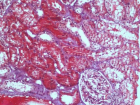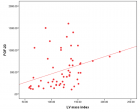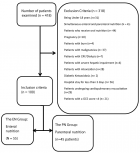Table of Contents
Emergency laparoscopic left sided colonic resection with primary anastomosis: Feasibility and Safety
Published on: 20th November, 2018
OCLC Number/Unique Identifier: 7943252570
Patients undergoing laparoscopic surgery had a lower incidence of major complications, such as anastomotic leak, intra-abdominal bleeding, abscess, and evisceration. Controversies about the operative management of left colonic emergencies are decreasing. Nowadays there is worldwide shifting towards primary resection, on table lavage and primary anastomosis. The aim of this study is to record the safety of laparoscopic primary anastomosis in left-sided colonic emergencies.
Patients: The study was carried out at Beni-Suef University Hospital, in the period between January 2016 and July 2017. Twenty-six patients were included in this study, twelve with left colon cancer, twelve with left colonic complicated diverticulitis and two cases with sigmoid volvulus. Patients presented clinically with either obstruction or perforation. All patients were subjected to laparoscopic resection, on table lavage and primary anastomosis.
Method: Decompression was done prior to starting the intervention, followed by resection and on table lavage then colorectal anastomosis using the circular stapler. The study was approved by the ethical committee in the faculty.
Results: Mean operative time: 185 min (160- 245).
LOS: 12 (10- 18).
Leak: one in obstruction group and two in perforation group.
Redo one in perforation group.
Conclusion: Emergency laparoscopic left-sided colonic resection and primary anastomosis can be performed with low morbidity, however with caution if there was free perforation with peritonitis
“Iliosacral bridging” - A new alternative minimal invasive fixation of unstable pelvic ring fractures
Published on: 20th November, 2018
Introduction: Fractures of both the anterior and posterior pelvic ring are common injuries in polytrauma and the elderly that extend beyond those of simple low-impact trauma. While conventional X-rays predominantly show the ventral aspect of the injury, computed tomography often detect additional fractures of the sacrum. A large number of these fractures are B-injuries by AO, mainly compression fractures at an advanced age. In addition, the prevalence of pelvic insufficiency fractures caused by osteoporosis rather than subsequent to an obvious trauma is increasing, with such an injury often associated with pain that impairs mobilization. The standard sacroiliac screw fixation is often characterized by loosening and thus failure of the osteosynthesis especially in osteoporotic bone of elderly patients.
Method: A new alternative surgical minimal invasive technique, the “iliosacral bridging”, stabilizes the fractures of the sacrum with an internal fixation from S1 pedicle of the uninjured side to the ilium on the affected side. The combination of this internal fixation with the standard single sacroiliac screw on the injured side allows an immediate full weight bearing and pain free mobilization. We present a case series of 8 patients.
Results: The clinical and radiological analysis analogous to the pelvic-outcome-score brought forward that 2 patients showed an excellent and 2 patient a good result. The other 4 patients achieved sufficient results.
Conclusions: The “iliosacral bridging” we have introduced in the present study provides evidence of an expected increased stability of the pelvis after B-injuries
Intra-abdominal testicular tumour--A case report
Published on: 17th October, 2018
OCLC Number/Unique Identifier: 7905949310
A 35-year-old man presented with swelling in the lower abdomen for 2 months. He was found to have left undescended testis. An ultrasound scan showed a solid floating pelvic mass. His chest x-ray and tumour markers for testicular cancer were normal. Exploratory laparotomy revealed the left intra-abdominal testicular tumour. Intra-abdominal left orchiectomy was performed. The patient made an uneventful recovery. Histology showed immature seminoma. A mass in the lower abdomen with a cryptorchidic testis strongly points towards the diagnosis of malignancy in abdominal testis. To prevent this complication all undescended testis gets orchiopexy before 2nd year or orchiectomy in post-adolescent life. But some cases remain unnoticed, which leads to this kind of presentation. So, we decided to present this rare and interesting case of intra-abdominal testicular tumour.
Actinomycosis of the appendix
Published on: 17th October, 2018
OCLC Number/Unique Identifier: 7906092415
A 40 year old woman presented to the emergency department with acute on chronic abdominal pain in her right iliac fossa. On history her pain had been present for over 6 months and had previously been investigated with ultrasound, CT and a diagnostic laparoscopy several months prior to presentation. Her pain had acutely worsened over the preceding two weeks. This was associated with two days of diarrhoea but nil other systemic symptoms. Her medical history was significant for immunosuppression with tacrolimus, azathioprine and prednisone post renal transplant for IgA nephropathy [1]. Her abdominal examination was unremarkable other than tenderness in her right iliac fossa and a palpable non-tender renal transplant. Her inflammatory markers, electrolytes and urine microscopy were unremarkable. She was further investigated with an ultrasound which demonstrated nil complications with her transplant and a non-contrast CT (due to contrast allergy). Her CT demonstrated a faecolith within the appendiceal lumen but no signs of acute appendicitis (Figure 1). Due to ongoing pain and CT finding of faecolith she was taken for a diagnostic laparoscopy with appendicectomy.
Figure 1: Non-contrast CT demonstrating faecolith.
Intraoperatively she had a macroscopically normal appendix and no other cause for the patients symptoms could be identified. A laparoscopic appendicectomy was performed with no complications. Her pain persisted postoperatively and she was discharged post operative day two with analgesia. Histology subsequently revealed actinomyces-like organisms consistent with actinomycosis of the appendix (Figure 2). Her case was discussed with the Infectious diseases team and she was started on an extended course of oral amoxicillin [2].
Figure 2: High Powered H&E stain & gram stain of actinomyces like organisms
Laparoscopic Cholecystectomy: Challenges faced by beginners our perspective
Published on: 23rd August, 2018
OCLC Number/Unique Identifier: 7828345636
Background: Laparoscopic cholecystectomy is gold standard and most widely performed surgery for gallstone disease all over the world. Surgeons entering into the field of laparoscopic surgery for the first time faces challenges that are different from those with experienced hands. We in this study tried to enumerate the various such challenges and also recommend few steps to counter them.
Aims & Objectives: To study the challenges faced by new surgeons in laparoscopic cholecystectomy and recommendations to reduce them.
Material & Methods: This study was carried out in a medical college in the department of General and Minimal Access surgery. In this retrospective study, ten general surgeons working as senior residents in in this medical college over a period of 3 years having never performed laparoscopic surgery in past were included.
Results: A total of 50 cases, five operated by each surgeon with minimal assistance by senior surgeon in few cases. Operative time varied from 90 to 120 minutes. The various technical challenges faced by the new surgeon were in the Creation of Pneumoperitoneum, Creation of second port (epigastric port 10mm), Gallbladder Retraction and Dissection at calot’s triangle, Dissection at gallbladder bed and Removal of the gallbladder from epigastric port.it has been observed that following various simple steps will abate these technical difficulties for these beginners while doing laparoscopic cholecystectomy.
Conclusion: Laparoscopic cholecystectomy is the most commonly performed minimal access surgical procedure nowadays and almost all the new surgeons enter the world of laparoscopic surgery via this surgery. Knowing and following the above recommendations will help them abate the technical challenges generally faced during the initial phase in the laparoscopic field.
Gossypiboma due to a retained surgical sponge following abdominal hysterectomy, complicated by intestinal migration and small bowel obstruction- A Case Report
Published on: 14th August, 2018
OCLC Number/Unique Identifier: 7828395684
A gossypiboma is a mass of cotton material from any source, left in a body cavity after a surgical procedure. This enhances the morbidity, cost of treatment and potential mortality to the patient with the addition of medicolegal issues. We report a case of a 32 year old lady who presented with complaints of central abdominal pain and vomiting for 1 month, fever for 20 days and non-passage of flatus and faeces for 5 days. She had undergone a total abdominal hysterectomy 4 months prior. On clinical examination, adhesive small intestinal obstruction was suspected. On CECT evaluation, a gossypiboma was suggested to have possibly migrated into the small bowel. Laparotomy revealed the presence of clumped bowel loops, which on dissection got torn and showed a gauze like material within the bowel lumen. A diagnosis of gossypiboma with intestinal migration of a retained surgical sponge was ascertained. The possibility of a gossypiboma, particularly in previously operated cases, must be kept in mind and measures must be taken to prevent such incidences.

HSPI: We're glad you're here. Please click "create a new Query" if you are a new visitor to our website and need further information from us.
If you are already a member of our network and need to keep track of any developments regarding a question you have already submitted, click "take me to my Query."


















































































































































